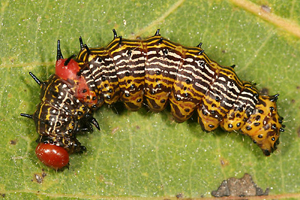Leaf Feeders
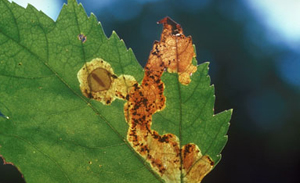
Lance S. Risley, William Paterson University, Bugwood.org
Birch leaf miners are flat, white larvae of a sawfly, a plant-feeding wasp. The larvae feed between the upper and lower leaf surfaces; mined areas of infested leaves turn brown as if blighted. The dark adults emerge from pupae that spent the winter underground beneath birch trees. Mining usually appears first in May. A second generation is active during June.
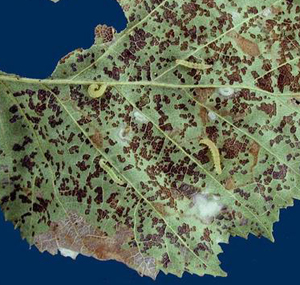
Ronald S. Kelley, Vermont Department of Forests, Parks and Recreation, Bugwood.org
Birch leaf skeletonizers are small light green caterpillars that chew twisting mines in birch leaves in mid-summer. After mining for about 2 weeks, the caterpillars will leave the leaf and feed externally for about 3 more weeks. Damaged leaves turn brown and drop prematurely. Raking and destroying fallen leaves will help to reduce damage the following year.

Lee Townsend, University of Kentucky
Japanese beetles can feed on about 300 species of plants ranging from roses to poison ivy but basswood is one of their favorites. They usually feed in groups, starting at the top of the tree and working downward, and prefer plants that are exposed to direct sunlight. A single beetle does not eat much; it is group feeding by many beetles that causes severe damage. Adults feed on the upper surface of foliage, chewing out tissue between the veins. This gives the leaf a characteristic skeletonized appearance. For more information, see Entfact 451.
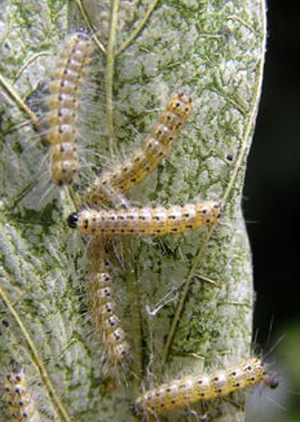
Milan Zubrik, Forest Research Institute - Slovakia, Bugwood.org
Fall webworms are small hairy white caterpillars that live communally in thin silken webs at the ends of branches. They may leave the tent to feed individually as they get larger. While the webbing is unsightly, feeding damage is usually limited to limbs around the tent. Large established trees are not seriously affected by small to moderate infestations. The larval stage feeds for 4 to 8 weeks and may be found on a variety of hardwoods. The first generation occurs in late May and early June, the second generation is usually larger and active from July through September. For more information, see Entfact 424.
At its largest, the Redhumped caterpillar is 1-1.5 inches long. The head and first abdominal segment are red, the rest of the body is yellow with black and white stripes. Black tubercles extend from the back. These caterpillars initially feed as a group on a single leaf, skeletonizing it, and use a collective warning display to ward off predators. As they grow, they will spread out as individuals and consume entire leaves. Mature larvae overwinter in the soil and pupate in the spring. Adults fly from June till July and caterpillars feed July to September.
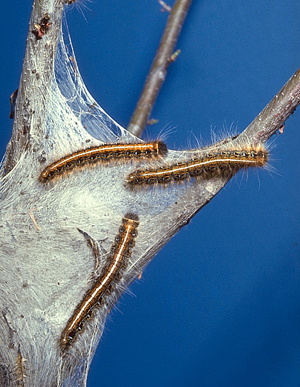
Robert F. Bassett, USDA Forest Service, Bugwood.org
Eastern tent caterpillar is a hairy black caterpillar with a white stripe down the back, brown and yellow lines along the side with a row of oval blue spots along the top line. The larvae live communally in silken tents. They feed for 4 to 6 weeks and may defoliate small trees. When mature, they wander to protected site to spin a cocoon. These tent caterpillars are active during April and May, there is one generation each year.
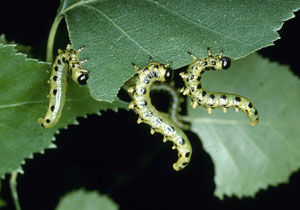
Lacy L. Hyche, Auburn University, Bugwood.org
Dusky birch sawfly larvae are yellow-green with rows of black dots and a dark head capsule. They feed in groups at the edges of leaves. If the larvae are approached, they will assume a characteristic “S” shaped defensive posture. There are two generations per year with larvae feeding from May-July and again in September-October. They overwinter as pupae in the soil. Adults are 1/2 inch long black wasps.
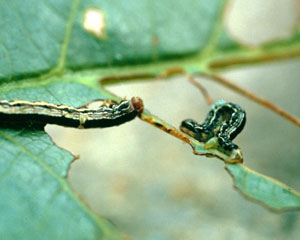
A. Steven Munson, USDA Forest Service, Bugwood.org
Fall cankerworm is a looper caterpillar that can vary from light green with yellow stripes to green with a dark stripe down the back. Overwintering masses of about 100 eggs hatch in later April or early May; small caterpillars chew small holes in young leaves at branch tips. Larger loopers leave only the midrib and major veins. Fall cankerworms are about an inch long when full grown. Mature larvae descend from trees on silk threads to pupate in the soil. They emerge as adults during periods of freezing temperatures to mate and lay eggs on host plants. There is one generation each year.
Sap Feeders
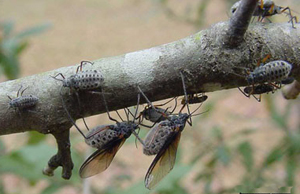
Herbert A. 'Joe' Pase III, Texas A&M Forest Service, Bugwood.org
Giant bark aphid is the largest aphid in North America. This sap feeder can live on several tree species. Winged forms disperse from tree to tree. Wingless aphids occur in large colonies. These aphids produce a large amount of sticky liquid waste, honeydew, which drips onto objects below. Feeding by large numbers of these aphids can damage or kill small twigs. They are eaten by lady beetles and other predators.
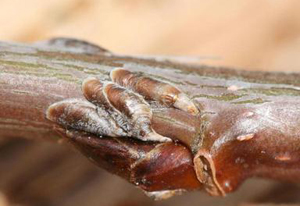
Whitney Cranshaw, Colorado State University, Bugwood.org
Oystershell scales are about 1/10 inch long and resemble crusty accumulations of oyster shells on the bark. Their drab, bark-like appearance makes them easy to overlook, even on close inspection. Heavy infestations can kill twigs or branches. This scale overwinters in the egg stage under the waxy covering of the female. The eggs hatch and the crawlers are active from late May to early June.
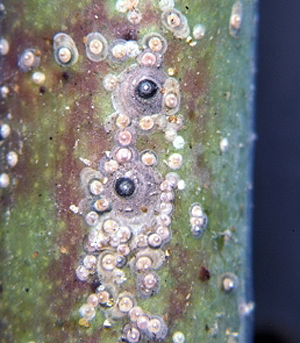
United States National Collection of Scale Insects Photographs,
USDA Agricultural Research Service, Bugwood.org
San Jose scale is one of the most destructive scale species. Infested stems, twigs or branched may be killed and heavily infested trees may die. These small circular brown armored scales have a series of dark concentric rings on their waxy covering. There are several generations each year. First crawlers are active from late May to early June, a second generation appears in late July and a third in late summer or early fall. Heavily infested plants may have a crusty covering of scales.
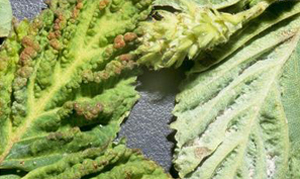
Jim Baker, North Carolina State University, Bugwood.org
Woolly birch aphid (also called witch hazel gall aphid) is easily recognized by a covering of wool-like strands. Females spend the winter on river birch and move to expanding leaves at bud break where they deposit live young. Feeding by the small aphids gives leaves a corrugated appearance. The small whitish aphids cluster in colonies on the undersides of leaves. Heavily infested leaves, usually a small number, become distorted and may turn brown. The aphids will mature in late June and fly to witch-hazel.
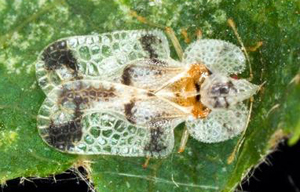
David Cappaert, Bugwood.org
Lace bugs are flat gray sap-feeding insects with clear, ornate, lacy wings; nymphs are spiny and wingless. Both stages live on the lower surface of leaves. As they feed, they leave tiny yellow to white spots on leaves and dark, varnish-like waste spots on the under sides. These lace bugs spend the winter as eggs under bark or in leaf litter. The eggs hatch in early spring and the nymphs begin to feed on plant sap. There are several generations each season. Initially, numbers are so small that feeding symptoms are not noticed until the population peaks in late summer. When abundant, feeding can make plants unsightly and may cause premature leaf drop.
Borers
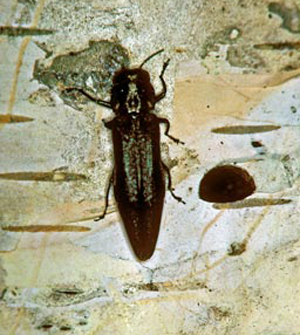
Steven Katovich, USDA Forest Service, Bugwood.org
Bronze birch borer most commonly attacks paper birch, European white birch, and gray birch, especially trees that are stressed by disease, defoliation, or adverse weather. The white legless larvae bore beneath the bark. Their tunnels, which appear as raised ridges, can girdle and kill individual branches or entire trees. Adults make D-shaped exit holes in the bark that ooze a rust-colored sap.
